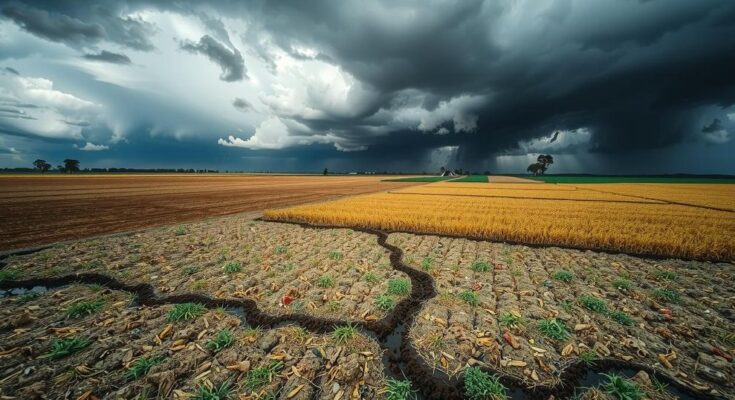Extreme weather is increasingly impacting agriculture, resulting in significant crop losses globally due to floods, droughts, and heat waves. Recent reports from regions like Tanzania, Vietnam, and Cambodia highlight these struggles as the impact of climate change complicates food production systems. There is urgent need for adaptation and resilience in agricultural practices to combat these ongoing threats.
Extreme weather conditions are increasingly devastating global agriculture, with reports from various regions documenting severe impacts on crops. Floods, droughts, and heat waves have resulted in substantial losses, such as corn being ruined in Tanzania and coffee in Vietnam, and pepper in Cambodia. Carbon Brief has compiled a map that outlines 100 instances of crop destruction due to such weather extremes across 2023 and 2024.
In analyzing media reports and resources from organizations such as the UN Food and Agriculture Organization, Carbon Brief noted that these weather events have escalated since the mid-20th century, as confirmed by the sixth assessment report (AR6) from the Intergovernmental Panel on Climate Change (IPCC). Experts express growing concern over the capacity of agriculture to withstand repeated extreme weather patterns.
The effects of extreme weather on crop production are both immediate and long-lasting, as evidenced by the devastation caused by a typhoon in the Philippines in 2012, which significantly hindered banana production for years. Changes in climate also necessitate that certain crops, like apples in Nepal, be cultivated at higher altitudes due to shifting environmental conditions.
Climate change interactions with agricultural risks amplify vulnerabilities due to a lack of resilience within food systems. As highlighted by Prof. Andy Challinor, these various disruptions can exacerbate existing risks and create unpredictable consequences, which complicate efforts at managing food production. Carbon Brief’s study revealed an array of crops adversely affected by extreme weather, necessitating a shift in agricultural practices.
Weather remains a crucial factor in agricultural yield; however, climate change is intensifying the occurrence and severity of these extreme conditions. Attribution studies like those from World Weather Attribution have linked specific disasters, such as floods in Brazil, to climate change influences. Similarly, droughts in southern Africa have been attributed to the El Niño phenomenon, impacting food production significantly.
This analysis emphasizes the impacts on crops alone, neglecting effects on livestock, which suffers as well. An extreme winter in Mongolia resulted in the death of over seven million animals, exacerbating rural unemployment and loss of livelihoods. Other effects include reduced milk yields due to heat in Singapore and rising disease incidences affecting crops because of warmer conditions.
While warmer weather can benefit specific crops in some regions, climate change poses significant risks to food production globally. According to the IPCC AR6 report, a 2C temperature rise by the century’s end would lead to severe negative consequences for food systems, with many currently productive areas becoming unsuitable.
Possible solutions to adapt to extreme weather include increased resilience in agricultural systems, which may require a transformative approach rather than simple adjustments. Prof. Elena Piedra-Bonilla stressed that small-scale farmers often lack the resources and capacity to adapt to current weather challenges.
Furthermore, while the IPCC outlines effective adaptation practices, financial barriers persist that limit their implementation in agrifood systems. The disparity in climate finance directed toward agriculture indicates a significant shortfall in needed support, highlighting the importance of government disaster relief and crop insurance initiatives to help farmers cope. Nevertheless, rising costs are making these safety nets increasingly unattainable.
In summary, the ongoing impacts of climate change will indeed reshape agricultural practices and challenge food systems worldwide. Immediate efforts to enhance adaptation strategies, particularly for vulnerable farming communities, are essential to counter these ongoing threats.
In conclusion, extreme weather conditions are profoundly affecting global agriculture, leading to significant crop losses and posing risks to food systems. The effects of climate change continue to exacerbate these issues, requiring urgent adaptations and increased resilience in agricultural practices. Stakeholders, especially small-scale farmers, need more support, funding, and resources to effectively cope with these ongoing challenges and ensure food security in the future.
Original Source: interactive.carbonbrief.org




